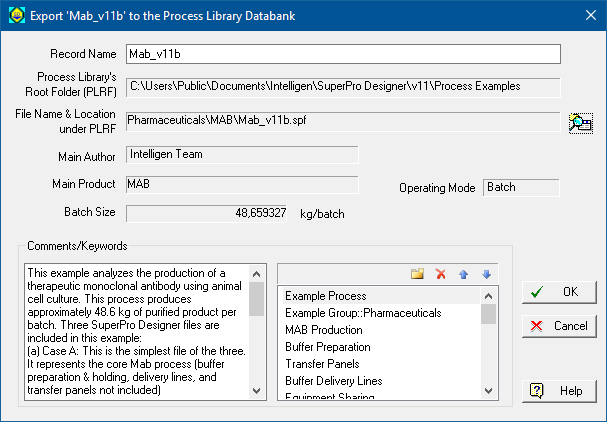

This dialog appears when you select Databanks } Processes } Export/Update Current Process... (Ctrl+F4), or when you click on the  button of the Process Library Toolbar.
button of the Process Library Toolbar.
After you have completed the simulation of a process, and you are satisfied with the performance of you process model, you can deposit it to your Process Library so it can become part of the pool of process models that you can search, at a later time, when you are looking for past models that contain a specific characteristic.
The most important fields to be set in this dialog are:
1. The file name to be used for the copy of the process model kept in the library’s area of documents (under the Process Library Root Folder, or PLRF)
2. The sub-folder (if any) under the PLRF
3. The name of the record by which this process model will be listed in the main catalog (table of contents) of all process models kept by in the process library.
None of the above fields can be modified after the file is deposited in the process database. Some of the other fields (e.g. “The Main Author”) are presented for viewing only and are either non-editable, or editable elsewhere (in Process Description Dialog). Others are part of the inherent nature of the process model and of course, can’t be changed (e.g. “Operating Mode”, “Main Product”, “Production Size”). .
|
|
The program automatically fills up the fields of “Main Product” if the user has chosen a main product / revenue stream (see Main Product/Revenue Rate Stream). Also, the “Production Size” will be filled in, if the simulation has finished successfully at least once.. |
Finally, the “List of Keywords” and “Comments” are fields that can be set/changed in Process Description Dialog but users can do some last minute editing in this dialog, just before the file is deposited in the library of processes
Please note that if there is already a record in the Process Database with the same record name and the reference process file (.spf) is in the exact same location and with the exact same filename, then upon exiting the dialog, the program will NOT create a new record, but simply update its internal description of that process model based on the current information contained in the file.
|
|
When depositing a process model to the Process Database please remember the following rules: When you choose to ‘sync’ your process library, the program will scan |
. The ‘User-Name’ field automatically displays the user name that the application has been instructed to use during the current session. To change the user name, please visit the File } Application Settings dialog (see Application Settings Dialog: Miscellaneous tab).
If this process was exported before under the same name as the default name (shown upon the startup of this dialog), then the previously recorded text under ‘Description’ and the previously recorded set of ‘Keywords’ will automatically be shown upon startup. In that case the fields of ‘Modified By’ and ‘On’ (meaning ‘last modified on’) will also be filled up. Otherwise, these fields will be empty. Either way, the user is allowed to modify these fields, before the record is actually exported to the process databank.
Notice that SuperPro Designer automatically fills up the value of ‘Batch Size’ (or ‘Rate’ for continuous processes) as long as the simulation has been carried out at least once and the user has selected a main product/revenue rate (see Main Product/Revenue Rate Stream).